In Vino Veritas
by mimithorisson
Uncle Henry: “Max, have I told you why I enjoy making wine so much?”
Young Max: “You don’t make the wine, Uncle Henry – that guy Dufot does.”
Uncle Henry: (Reproachfully) “In France it’s always the landowner who makes the wine, even though he does nothing more than supervise with binoculars from the comfort of his study. No, I enjoy making wine, because this sublime nectar is quite simply incapable of lying. Picked too early, picked too late, it matters not – the wine will always whisper into your mouth with complete, unabashed honesty every time you take a sip.”
From the film A Good Year based on the Peter Mayle novel
Making wine is dreamy proposition, especially if you love wine and like … making things. It’s a movie-like fantasy many of us share, to buy a plot of land, plant some vines, watch them grow. To open a bottle of the family wine to match the Sunday roast, to set aside a few cases of your children’s birth vintages to celebrate their achievements in the fullness of time (and perhaps a few bottles extra for the failures).
This summer we bought a beautiful château, albeit one without vineyards. In it’s heyday our new house was part of a larger estate, a proper wine making château that produced glorious wines, but as time passed land was sold, perhaps to settle debts, and now all that remains is a magnificent building with enormous corridors, high ceilings and the grandest rooms. But with no vineyards.
The empty cellars are crying to be restored to their former glory, the shelves dream of being once again stacked with thousands of bottles of wine. (There are of course some hundred bottles of wine in a far corner of the “cave”, pleasing on the eye but much less agreeable on the palate. The previous owner told me I could use them for sauces, but I think even that won’t work – maybe for Halloween?).
So how do you solve a problem like a château without wine? Oddur and I discussed this at length and indulged in fantasies of buying land, building a winery and hopefully making decent wine. We drove around the vineyards near St Yzans, talked about blends and character, we even agreed on the label. There would be a dog on it, a Smooth Fox Terrier, it would be simple, either white or red and in the end we agreed on the name “Humfri”. So that’s as far as we got until more practical matters occupied our plans, things like plumbing & electricity. So Humfri the wine remained just an imaginary bottle, something that only the ghosts of St Yzans could enjoy.
One of our favorite winemakers are the Cazes family of château Lynch-Bages. They along with a number of other winemaking families have evolved from being a name on a bottle that we loved to drink in Paris to becoming friends in Médoc. Late this summer I had a conversation about my winemaking aspirations with Jean-Michel Cazes and his daughter Kinou, asking them for advice on my little “dilemma”. For them the solution was staring me in the eye, I should make a wine with Viniv, a winemaking enterprise they co-own with a charming French/American named Stephen Bolger (who is now the proud owner of one of our Smooth Fox Terrier puppies from this summer).
I was vaguely familiar with Viniv, had always thought it interesting and this was an opportunity to find out more. To make a long story short Viniv has several vineyards in Bordeaux, in Médoc and on the other side of the Gironde, which we call the right bank. So we visited the vineyards, got to choose which plots we’d be making the wine from (Merlot from the right bank, Cabernet Sauvignon from Pauillac and St. Estèphe – sounds good right?). We accompanied the technical gurus of château Lynch Bages to the vineyards as they chewed on grapes, debating when would be the ideal time to harvest and on several occasions the whole family participated in the “vendanges” itself, picking the grapes by hand, row after row and then sorting the good from the bad once we had returned to the winery. In the fullness of time we will be choosing our blends, guided by one of the finest oenologues in the world, Eric Boissenot, who is already a friend. The good news: 2014 will be a spectacular vintage for Bordeaux wines.
So if you find yourself one day, holding a bottle of Humfri, you will know how it all started.
Of course the best thing about the harvest are the harvest lunches and we’ve been to quite a few this year. These are joyous affairs, where the châteaux reward the hard work of those in the field, us included, with good wine and a hearty three-course meal. In France nobody goes hungry during the vendanges. We’ve had Basque pork chops and museau de boeuf, pot-au-feu, poule-au-pot and the most sumptuous desserts. All these lunches have inspired me to make a vendanges menu of my own, a seasonal, luxurious but fairly easy to make three course meal that would satisfy any vigneron. Since cepes are literally everywhere and we’ve been having them every day, those had to be included. This summer we had a delightful mushroom dish in San Sebastian at a tapas restaurant called Ganbara (which I highly recommend), pan-fried cèpes with a simple but a game changing egg yolk in the middle. For the main I had to go with pigeons, infused with more cèpes and figs, just like a walk in the woods. And what could be more fitting for a harvest lunch dinner than Chasselas grapes from my grandmother’s hometown of Moissac in the south-west, drenched in the richest red wine caramel and paired with even more figs.
Truth in Travel
This summer we had the pleasure of shooting a story for Condé Nast Traveler, a ten-page feature on our beloved Médoc. It turned out much more eventful than we could have ever imagined, we fell in love with the creative director of the magazine, Yolanda, and her family, they fell in love with Médoc and the rest is history … and of course a feature in the November issue. We are thrilled to bits to promote Médoc, I think the story turned out great and we even got the cover. I think this must be the first time that the word Médoc is on the cover of that illustrious magazine and to think that I had something to do with that makes simply makes me proud.
Here is a link to the story & photos and there is even a lovely little video on Médoc, shot by Yolanda’s husband Matthew Hranek.
And talking about travel, in about 3 hours we are heading to Paris with a dog and two girls to be there for the launch of my book, A Kitchen in France, that (even if it’s hard to believe) comes out TOMORROW!. Oddur and I will be giving a talk at the American Library in Paris (Rue Camou, 7ème) on the 28th October at 7:30 pm (yes, tomorrow!) and it would make me ever so happy if some of you could come and have a chat with us. Click here for all the details.
The Prints
When one thing begins sometimes another ends. Tomorrow is the first day of my book’s life but it also marks the end of the pre-order period and the complimentary prints for those who pre-order.
But you still have one final day to get yourself a print.
Available for presale on
Amazon – B&N – Indiebound
To receive the print, you simply have to click here and fill in your details.
Cèpes & girolles with egg yolk
This simple and amazing dish was inspired by this summer’s visit to San Sebastian, Spain. We dined at Ganbara, a superb restaurant with local specialities. Each dish arriving at the table was a pure delight, but the one that stuck me most was the grilled mushrooms with the golden egg yolk in the center.
Per person
A handful of cèpes and girolles
1 organic egg yolk
Sea-salt and freshly ground black pepper
A sprig of parsley, leaves picked and chopped
Slice the cèpes 1/4 inch thick.
Heat the sauté pan until very hot. Add the sliced cèpes, season with salt and pepper. Cook on each side until golden, then add a knob of butter. Transfer to a serving plate and place the egg yolk in the center. sprinkle with chopped parsley. Pour yolk over mushrooms. Serve immediately.
Pigeon with figs & cèpes
There’s something so autumnal about this meal, so deep in colors and flavors… as if you entered the forest. The pigeon, cooked with the figs, the cèpes and the red wine makes this dish unforgettable.
Serves 3-4
3 tablespoons butter, unsalted
2/3 pigeons, cleaned and cut into 4 pieces
1 onion, sliced finely
1 large turnip, sliced
1 clove garlic, sliced finely
160 ml/ 2/3 cup red wine
160 ml/ 2/3 cup chicken stock
A few sprigs of thyme
8 figs, quartered
About 2 to 3 large cèpes, sliced
Sea-salt & freshly ground black pepper
In a large dutch oven, melt the butter on a medium heat. Cook the pigeons on all sides until golden. Season with salt and pepper. Set aside on a plate and keep warm. In the same pot, cook the onions and garlic for 5 to 8 minutes. Add the sliced turnip. Pour the wine and reduce for 3 minutes. Add the chicken stock, figs and thyme – stir gently. Meanwhile, heat a sauté pan until very hot. Add the sliced cèpes, season with salt and pepper. Cook on each side until golden, then add small knob of butter. Add to the pot. Return the pigeon to the pot and cover. Transfer to a preheated oven 170°C/ 340°F for 25 to 30 minutes. Serve immediately.
Roast figs and Chasselas grapes with a red wine caramel
Serves 4
8 figs, cut in quarters
A few small sprigs of Chasselas grapes
For the red wine caramel
1/3 cup/ 65 g granulated sugar
1/3 cup/ 80 ml red wine
Make the sauce:
In a small saucepan, combine 1/3 cup/65 g of the sugar and the wine and bring to a low boil, stirring to dissolve the sugar. Lower the heat slightly and cook, stirring occasionally, until the mixture thickens to a syrup, about 5 to 6 minutes.
Slice the figs in quarters and place in an oven-proof dish. Place a few small sprigs of chasselas grapes all over. Transfer to the oven on the grill setting until the fruits are roasted, about 3 to 5 minutes depending on oven strength. Drizzle the red wine caramel over the fruits and serve immediately.

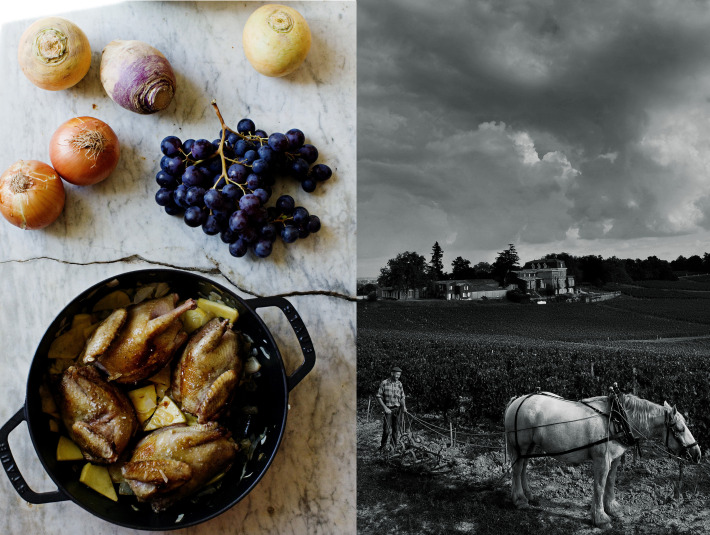
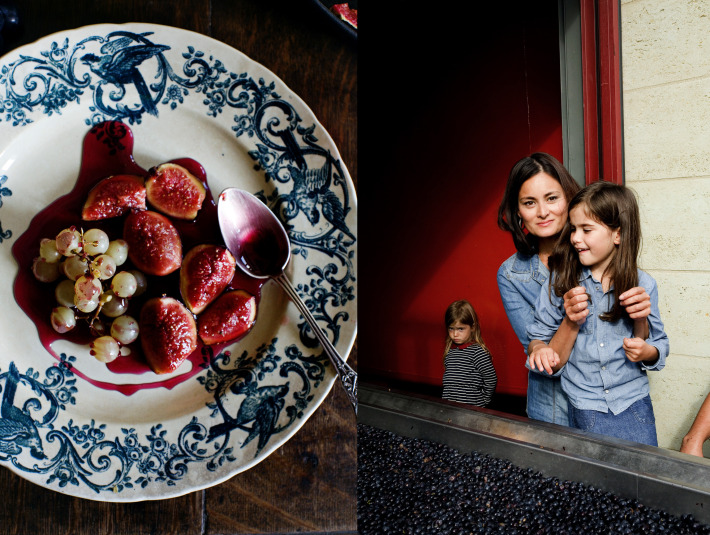
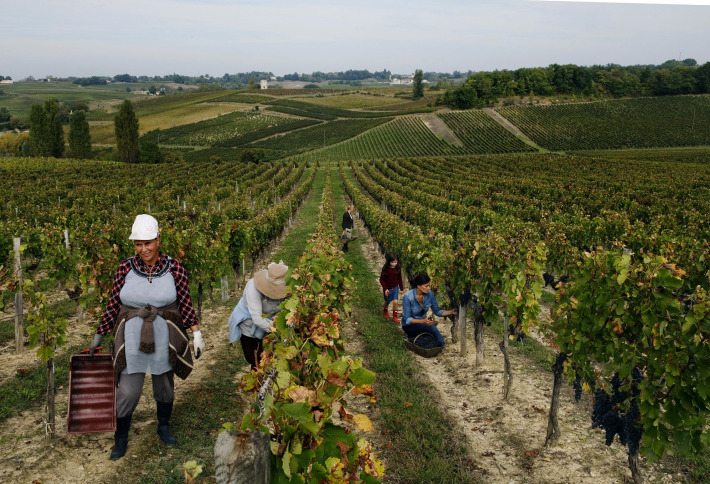
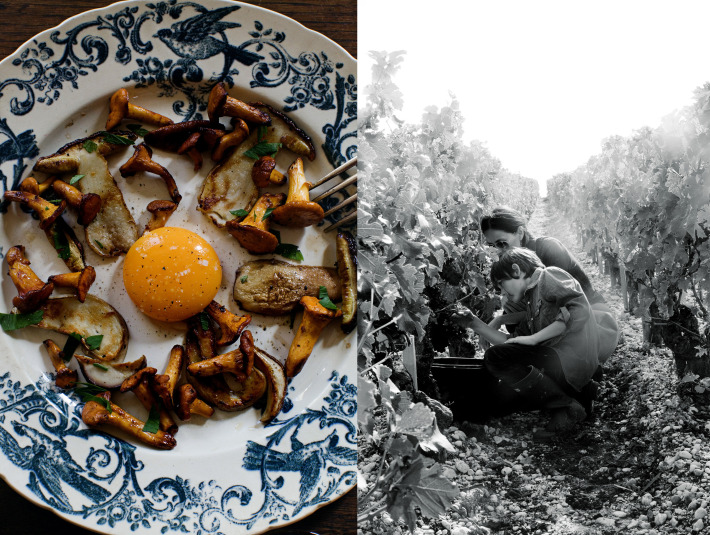

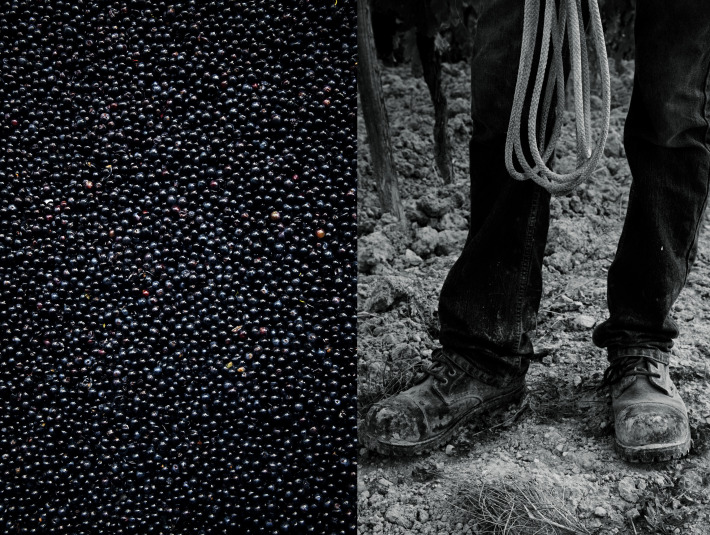
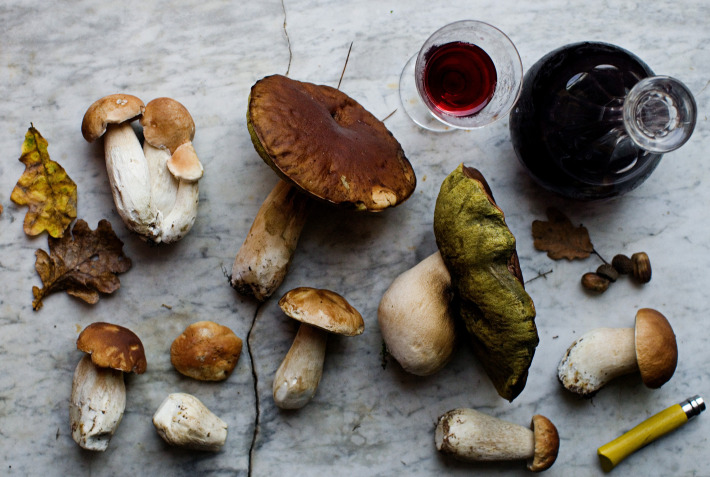
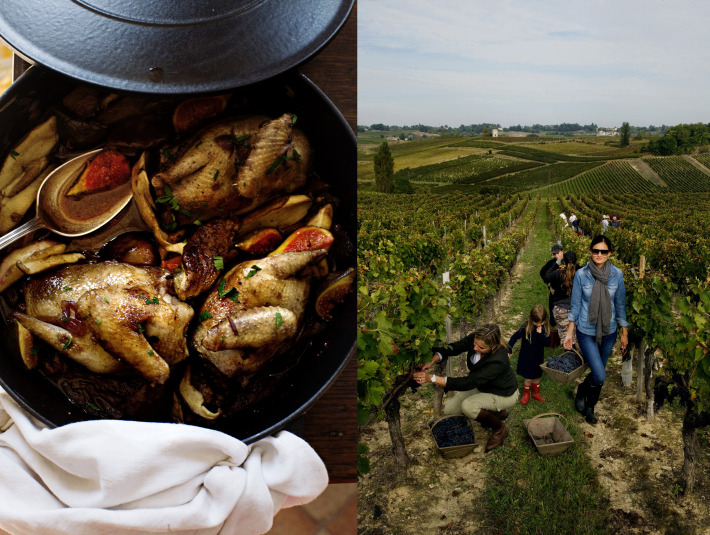
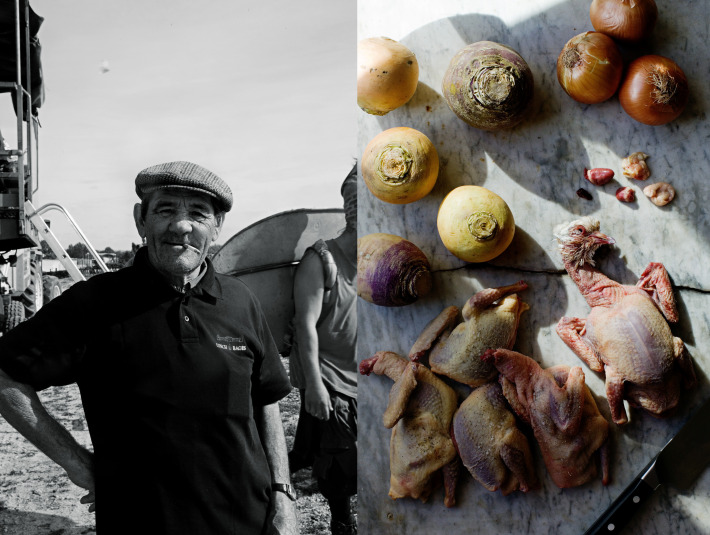


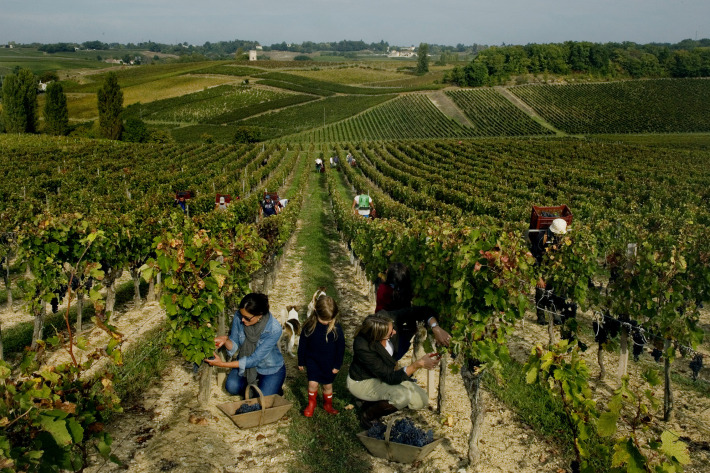


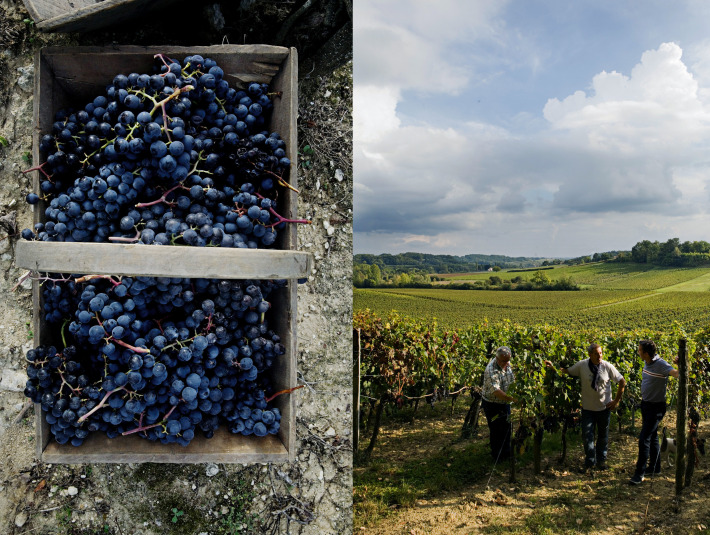

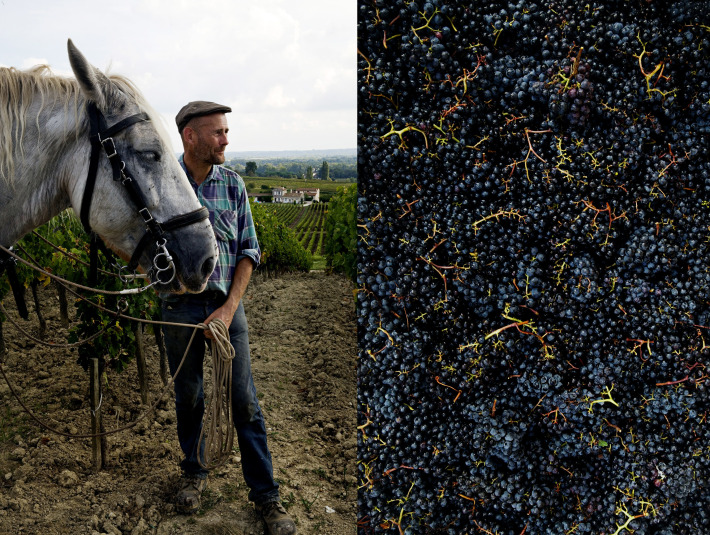
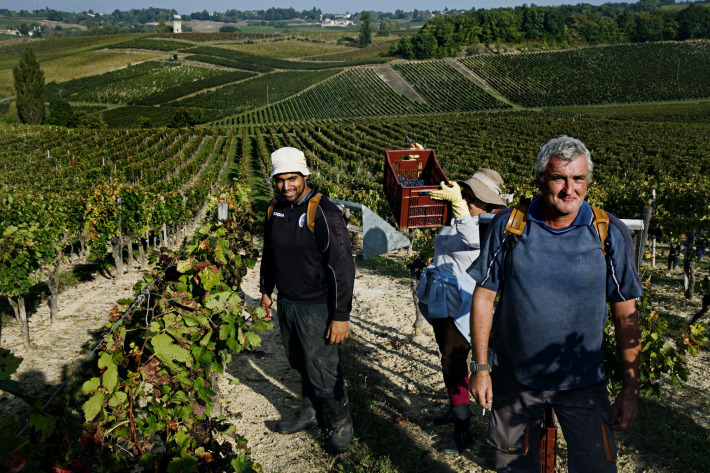

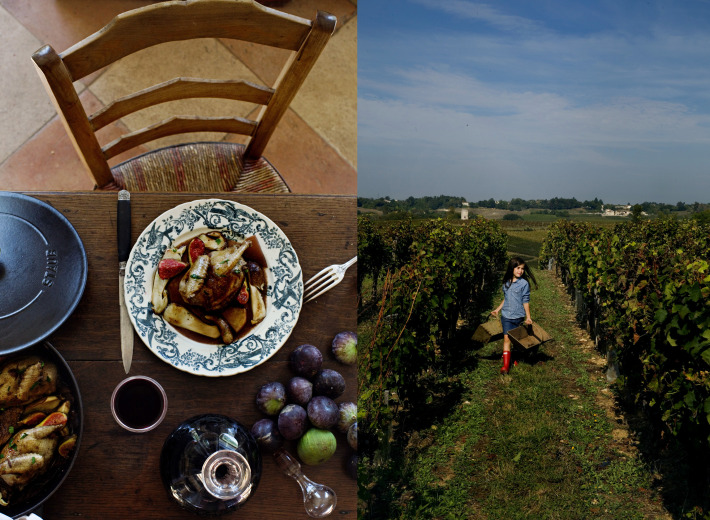

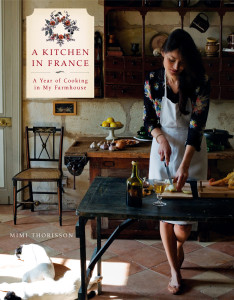
Oh my…
Those pictures are amazing! And who doesn’t dream of making their own wine?? I certainly do and when a friend of my parents sold their vineyard, my dad told me that he was dreaming about this as well.. So I’m really happy for you, especially as I understand this urge so well.
I will keep the Humfri in mind and will look out for it for sure. 🙂
Also, I would love to join the party in Paris. I’ve been longing to go back and enjoy sweet life. Very soon I hope.. 🙂
Enjoy your trip and all those exciting things happening in your life at the moment. 🙂
Merci Tina! We just came back from Paris today after a whirlwind trip – I was so incredibly touched last night by the turnout at the American Library… Hope to meet you soon! Mimi x
Hello Mimi,
There’s nothing I like more than getting to read a new post of yours on a monday morning !
I stop everything I was doing (like … working …) and I read your article. The phone may ring, someone may come in my office, I don’t care, I am busy, don’t disturb me now. Is that bad ?
Thanks for that lovely story. I’ve had a few cepes omelettes this autumn. My brother in law is really good at finding and cooking them. I just supervise the operations with a glass of wine in hand.
Good luck for tomorrow. Looks like your book is already a great success before it’s even out.
I can’t wait to get my copy and see you on the 30th of November.
Alice xxx
Bonjour Alice! Your comments always make me smile 🙂 Oh la la, Paris was so exciting – seeing my book on the shelves of my favorites bookstores, meeting so many charming people at the American library… I was feeling quite emotional and shaky at first! See you very soon, cooking from ‘Tout est bon dans le cochon’ with Eric Ospital & Etchebest. Wohou! I’ll get to meet you finally 🙂 Mimi x
Hello Mimi,
Thanks for making us part of what will be the beginning of your winemaking history (Humfri will retain the name because it is clear that I would love to try it). I wish you enjoy a lot in the book presentation, sure to be a hit !!!
A big hug and good riddance!
Merci Yasmina! The book is out – it’s been so exciting, from spotting the book on the shelves of bookstores, meeting so many charming people at the American Library last night – it’s unbelievable 🙂 Mimi x
Hi Mimi,
Realize you’re probably run off your feet with the book being out (amongst other things I’m sure), but wondering if it would be possible to request information.
We are in the Medoc area searching for a rural long term let (or winter let). (Want to rent until we are sure we want to stay long term and buy). We have dogs so want to be out somewhere peaceful and quiet I.e. Not annoy neighbors. (Willing to consider a caravan in a field at this stage so that we can stay in the area 🙂 )
Just seem to be struggling to connect locally, seems to be mostly word of mouth; and wondering if you have any info or could push me in the right direction of a person to connect with. Any help great appreciated.
Regards
Alex 078 993 8730
Hi Alex, thanks for reaching out. Let me just get back to you via email when I have more time to think of this. Cheers, Mimi x
Mimi, congratulations!
I look forward to receiving a copy of your book! I love your photography and writing!
Can hardly wait to go to the South of France for Christmas: -)
All the best1
Oh merci! I can’t wait too – perhaps you have received it by now? Enjoy the book – and thank you! Mimi x
I love you two, because you are not afraid to dream big. And Humfri wine – priceless!
🙂 Merci Bette! Sometimes, it’s all about taking risks and pursuing your dreams till the end. It’s definitely worth it! Mimix
Mimi,
I just ordered your book from Amazon. Your blog is like turning the pages of a French culinary magazine enriched with French lifestyle. I love it! Looking to the photos and reading your words, I always hear “a person should do what he/she loves. Success will follow.”
Otherwise, something took my attention, the banner on the top of your blog page, it is also on the cover of your book, may I ask who is the illustrator? I really like it, it couldn’t be more expressive about your blog overall.
Best,
Betül
Thank you so much! I am so hapy to hear your kind words. The illustrations are from Anna Bond from Rifle paper co. – she’s so talented. Mimix
Dreams of wine-making consumed my man’s thoughts a decade ago. Then I reminded him there’s only one vintage per year, and a long wait until the following year for another – but he’s much older than Mimi and Oddur! The possibilities attached to your new venture are boundless. AND tomorrow SHE is released! Enjoy all the excitement. I’m not sur how long Uncle Amazon will take to deliver my copy. Oh to be in Paris with family, dog and book!
Thank you Jude! Yesterday was a huge day – I was filled with joy, especially meeting so many wonderful people at last night’s event! Merci for your kind words – Mimix ps: Fingers crossed you will receive the book today?
Dear Mimi,
Making your own wine! Congratulations! Thanks for this post, for everything you share… We went to Hortense last saturday as we usually try to do when we stay here and my husband and I just had a cassolette de cèpes du Médoc! This made me think of you!
I won’t be in Paris tomorrow and regret it but the weather is so amazing here! Summer is back… See you soon and can’t wait to read my book! Félicitations et à bientôt,
xx Cécile
Bonsoir Cécile! Oh Chez Hortense in this beautiful weather! Pure bliss! Last night was wonderful – I couldn’t think of a better way to celebrate the book’s publication than being at the American Library in the 7th – my old headquarters! Happy holidays! Mimi x
The books seems wonderful!
This made me homesick now.. I’m from Portugal and my grandparents have a farm with a very small vineyard and they make their own wine! I remember being a kid and jumping up and down to smoosh those grapes. 🙂
Merci! It’s so wonderful to be part of this winemaking experience – I love every single step of the process. Lovely souvenirs you must have! Mimix
Dear Mimi
I am always delighted with your photographs, recipes and posts.
Each day that passes I whish more to visit your magic farm.
A big kiss
Cláudia
Merci dear Claudia! Mimi x
I can hardly wait to receive my book tomorrow. I love your dream of your own wine and I’m sure the label will be a work of art. You do everything with panache.
Merci dear Penny – I am so happy to hear you will receive it today! Enjoy the recipes and stories. Mimi x
I love seeing your beautiful photos..and mini Mimi with you:)
Merci Monique 🙂 Mimi x
Mimi, today started out so gloomy with rain, wind and such cold that I was certain I would feel rather unhappy all day. And then I decided to spend some time on Facebook while I enjoyed my coffee and low and behold, a new blog post! Your posts always cheer me up and usually inspire me to head straight to the kitchen as soon as I’ve finished reading and commenting! It’s rather funny that you shared a quote from the movie “A Good Year” as I was listening to the soundtrack this morning!
While our selection of French wines can be fairly limited on the little Island I call home, I do hope that some day I come across a bottle of Humfri. My husband and I prefer French wine to any other and a wine with a Fox Terrier on it all the way from Medoc sounds heavenly! Thank you once again for sharing your beautiful words, pictures and recipes! They always come on the days I need them most 🙂
Oh you and I must have our stars aligned! 🙂 I am so happy to be part of your life, and hopefully we will enjoy a glass of wine together in the Médoc! Mimi x
Mimi, you are always so inspiring. Every post makes me dream and you succeed in transporting me to Medoc and making me dream of visiting the Chateau and vineyards. Yesterday I bought a digital copy of Condo Nast just to read your story. Congrats. It is just wonderful. Loved it. Then I was able to watch your show on Zest (une chaine de cuisine au Quebec) with my daughter Lola. You were really good and so natural. I just discovered we can watch your show in Canada. I was so pleased. Lola (11) also loved watching the show with me. Can’t wait for my copy of your book to arrive. I preordered it for a month now. So I want to congratulate you and wish you all the best for the launch. I am sure it will be a success. You have passion and it shows. Best wishes to you and Oddur. Bonne chance.
Bonjour Karine! I am so touched to hear from you. A huge thank you for showing so much support – I did not know the show was airing in Québec! Makes me so happy to know your daughter and you enjoyed the show! 🙂 Mimi x
I love the simple, but heartfelt recipes you’ve featured here. They speak to the quality of the ingredients with which you cook, and of the wine of your region (which you will hopefully help to immortalize in a bottle of Humphri one day!). Thank you for sharing this glimpse into a beautiful, simple and inspiring life.
Thank you! We are so enchanted to continue our adventure making wine – seems like the perfect next steps as local Médocains. I hope we can share a bottle someday! 🙂 Mimi x
I love seeing people cook cepes. There is very little of that going on in Vancouver, and, I suspect, North America, but being Czech, I collect wild mushrooms and cook them all the time. 😀 Congratulations on the wine agreement and good luck with a fantastic vintage. Robert and I have also agreed on a wine label, (when I have a spare two million and can buy back my family Chateau Alemann in Geneva…lol) He doesn’t drink any alcohol and se we will call our wine “Robert won’t drink this red” and “Robert won’t drink this white” Lovely article and lovely little video, and, I remembered to fill in the preorder photo offer just in time. So looking forward to the book. Have a lovely week, although I fear it might be full of wallpaper and paint and moving furniture.
Bonjour Veronica! First of all, so sorry for responding late – I am usually quite good at responding promptly, however these past months have been quite eventful and I find myself never being on time… for anything! I was saddened to hear of your news in my previous post… all I can say is that I feel you are an incredibly strong woman, and I have no doubt you will conquer everything with grace. Am thinking of you all the way! As for the wine labels, I chuckled inside remembering a super wine label ‘Robert est un con’ (ooops bad vulgar word here!) – it’s a super wine made by two winemakers that fell out, so the wine ended up being called ‘Robert est un con’! (Robert is a cunt’)… I can’t wait for you to receive the book – lots of love, Mimi x
Congratulations on everything Mimi! You have so many good things happening and I couldn’t be happier for you all.
I have no doubt that one day there will be a vineyard and a beautiful bottle of red Humfri! I’m waiting for it.!
My grandfather used to make wine in his basement many years ago. When I was younger, I remember thinking how special that was and was happy when they let me have a sip at dinner….not nearly as romantic as a vineyard in France though!
Merci beaucoup! We are so happy to embark in this new wine adventure – I couldn’t think of a better step to feel part of the ‘earth’! How lovely to hear your papy (grandfather in French) also made wine – I was always allowed a few sips as a child… I remember how it made me love my food even more! Mimi x
I look forward to uncorking a bottle of Humfri in the near future! We’ll be in France tomorrow, actually, but heading West to Brittany – we keep missing each other! All the best for your talk, I would love to have been there! x
Oh we keep missing eachother! I say, let have a bottle together soon! Mimi x 🙂
Congratulations – I can’t wait to read your book! Much success!
Thank you! Mimi x
Great pictures (as always)! Recipes like mushrooms with egg yolk impress me very much with its simplicity – simply divine!
Regards from Zurich,
Andy
Merci Andy! I get so inspired from great restaurants – this is a classic example of having great simple food! Mimi x
I love your dreams, they coincide with mine! But you are living them so I’ll vicariously live through your blog 😉 I am 100% considering making these recipes for American Thanksgiving next month. I’m over our traditional dishes and these sounds divine.
Oh what a treat! I am so honored you are considering these recipes for thanksgiving… thank you! Best wishes from Médoc, Mimi x
Bonjour Mimi! You truly live a magical life that I must admit is hard for me not to be envious of! 🙂 I cannot wait to purchase the latest issue of Conde Nast Traveler! I’m seriously one of your biggest fans and wish I could be at your talk in Paris! How truly amazing! I think you should have a workshop on how to live a fabulous life!!! haha 🙂 Congratulations on your new family wine and all of the amazingness that is happening for you and your family! xo, dana
Merci Dana! I feel so guilty not responsing sooner, so please forgive me. It was such a blast being in Paris, meeting so many wonderful people at the book launch event 🙂 I hope we will meet soon! You have probably got the issue of CNT by now – I hope you enjoyed it – so now you’ll really have to visit Médoc! Mimi x
Good work, I love all your pictures!!
Cheers Amy! Mimi x
Bonjour Mimi,
aurons-nous la joie et le bonheur de pouvoir commander un jour votre livre traduit en langue française?
Bonjour Mimi,
I will happily plan my future visit around the harvesting. Working in the sun like that looks very appealing. I am so happy to receive the book soon, I love Gia’s pout in the top photo! AB
(sorry, Gaïa’s pout)
Oh my goodness – another rapturous post! I clicked the link to the Conde Nast article, read the magazine feature through, & watched the video – totally charming. I wish I had access to your TV shows. However, as of tomorrow I will have your book in my hands – I already know it’s going to be a real treasure. Thanks for the totally inspiring recipes you shared with us today – I especially love the wild mushrooms with an egg yolk photographed on my favorite plate. You should completely enjoy yourself at your book launch in Paris – what an exciting time this is for you & your family – congratulations !
It’s me again – this time with your book, yes, I got it !! Mimi, it’s a glorious production – wow, it’s beautiful ! Even the paper is perfect for showcasing Oddur’s compelling photographs. The whole book just sort of takes you in, and the details are charming – like the fonts used for the seasonal titles and the recipe titles, and Anna Bond’s tiny illustrations. Double spacing the text ! – that’s pure luxury, I love that. I’ve read just a little bit of your seasonal introductions and a couple of recipes, couldn’t wait to write to you. The thing is I already know your writing style from Manger posts, always so friendly and inclusive to your readers. Your book is going to make wonderful Christmas presents this year ! Much happiness to you and your family, Mimi !
Thank you Linny! I couldn’t be more grateful for such a ripe month – from the book, the CNT cover and article… but what warms my heart most is knowing that my dearest readers are holding a copy of my book. And actually liking it! 🙂 Thanks for being so kind, so supportive… couldn’t have done this without you! Love, Mimix
Congratulations on your new book! I love “A Good Year” too, the pictures of your family make me think of that movie all the time! Best wishes!
Merci! Brings me such joy to share the book with the world! It’s out now! Love, Mimi x
Congratulations on your beautiful new book, Mimi!
I came across some copies in a bookstore on the Rue de Rivoli a couple of weeks ago. Now I know what I’m giving myself for Christmas.
Oh la la Rhonda – I am so touched! Merci! Mimi x
Mimi, this is so magical! I’m going to try your forest feast, but maybe with a pheasant from my butcher instead, and I hope to try a bottle of Humfri one day.
Bonsoir Myriam, I hope you’ll enjoy the recipes! And yes, I hope there will be Humfri wine for everyone too! This 2014 year will be a great one. Mimi x
My husband shares this fantasy as well. I support it since it would be therapeutic and rewarding work instead of the shark pit of stress he endures these days. Viva le humfri!
Yes, vive Humfri, the wine! Now, everytime I look at the dog, I see his lovely face, but also a beautiful bottle of wine 🙂 I hope we’ll get to have a glass together! Cheers, Mimi x
Hi Mimi,
Looking forward to the Conde Nast Traveler article! Also planning a trip to Medoc from Paris next Sept….though the trip seems like a long journey, even on the TGV, but I am hoping your cooking school/inn will be opened by then!
These pics make me want to be there!!!!
xo Stacey
PS can’t wait to receive my amazon copy of your book tomorrow! woo hoo!
Oh la la! I just saw your lovely message on my FB page – so keen to know which recipes you bookmarked! Enjoy! And by the way, I will be in New York mid november – so stay tuned 🙂 Much love, Mimi x
So excited! Just ordered the book right now from Barnes and Noble!
Merci Valerie! Mimix
… was watching CBS This Morning last week and they were talking about travel and showed latest copy of Condé Nast Traveler and there you were on front cover – how exciting!
Asking my library to purchase your book! Congratulations!
Thanks Ginger! I saw that fooatge too on you-tube. Thanks for everything, and I hope you will enjoy the book. Mimi x
Hi Mimi..would you believe on the day of your launch and release of your book I have a copy in my hot little hands!!! In Australia! Yes, the postie just dropped it off and can I just say a BIG CONGRATULATIONS to you and Oddur on such a stunning publication. Glossy, heaps of beautiful photo’s and of course your lovely recipes.
Now I can’t wait to receive my own little print from you guys..in advance, thanks heaps!!
All the best, Christiana
Oh so happy to hear you got the book! Hurray! Thank you so much – I can’t wait for you to receive the print too! Merci! Mimi x
Just finished the T&L article and wow – could not resist a bit of armchair travel on Google Earth to check out Soulac-sur-Mer – discovered that it’s the most charming town ever! So clean and tidy and seemingly free of hideous modern metal and plastic buildings. May it stay that way forever! And best of luck with the new vini-venture!
Merci Tunie! You can’t imagine how happy I am to share Médoc with the world 🙂 Soulac is a wonderful family-style sea-side place, with pretty house, beaches and a superb market. What more could you ask for? I hope you’ll visit someday! Mimi x
So looking forward to receiving the book, and if you expand your book tour to Tokyo, I’ll be there! Thanks again for the wonderful photos and recipes; terrific T&L story, too!
Thanks Tracy – CNT was always my favorite travel magazine, so you can imagine how I felt! Mimi x
Bonjour Dear Mimi,
Today is the day your book comes out!!!!!
What excitement for you and us!!!!
I’m thinking of all the recipes I’ve made of yours over the last couple of years and Calvados Apple Tart would have been the first and still my families favourite.
The postie must be bringing my copy soon and I can’t wait to get a hold of it.
Mimi, plumbing and electricity are highly overrated………go make that vintage…ha ha . The world is waiting for a bottle of Humfi to put in the cellar xx Anita
p.s. Mimi, I’ve now a web site for my bed and breakfast…….launched today!!! http://www.vueatjindivick.com. You’re going to need a place to stay when you do the “down under” book tour!!!!
Bonsoir Anita! Oh, I just checked your site – I WANT a view over Mt Baw Baw. I am so happy for you – it looks and sounds magical! And only one hour away from Melbourne… Bravo Anita. If ever I make it to Oz, I sure will knock on your door. Had a fantastic time in Paris – felt amazing to meet everyone at the American Library! Hope to see you soon? Mimi x
Congratulations Mimi… I can’t wait to have your recipes all in one place… your new book… 🙂
The article and video was wonderful… xv
Merci Vicki! So happy to hear you enjoyed it! Much love, Mimi x
You picture autumn so beautifully, both in photos and dishes! One can almost feel the autumn sun on one´s nose…
We’ve been so lucky with this warm autumnal weather – it’s still amazing out there, perfect for cèpes mushrooms picking! Mimi x
Mimi, congratulations for so many great things! Could you tell me please, is your cookbook available at any bookstores in London?
Hi Tara! Thank you! I was in Paris a few days ago, and it was available at all English bookstores. I assume it will come to London too, perhaps if you try American bookstores first? Cheers, Mimix
Congratulations on your new book and your new venture! I know your new book will be a tremendous success, and I can’t wait to see it. Your recipes all look delicious. Except for one. I know this will make me sound hopelessly American . . . but I cannot imagine eating a pigeon ha!!
Thank you for such kind words! Oh, I can understand pigeon is not to everyone’s liking 🙂 Mimi x
Hi Mimi,
I was very happy to read the article in Condé Nast Traveler, Oddur’s photography is Amazing, congrats and good luck, in the wine making, what a beautiful dream coming true.
Wishing you great success with your book, can’t wait to receive my copy xoxo
Thank you Rowaida – your kind words mean so much to me! Much love, Mimi x
Grâce à l’interview de Géraldine Dormoy du Blog Café Mode, j’ai pu faire la découverte de votre superbe et talentueux blog. C’est donc avec grand plaisir que je serais présente ce soir pour vous rencontrer, découvrir votre univers autour de votre livre et avoir une belle dédicace de votre part Mimi pour ne pas oublier ce beau souvenir.
Bonsoir! C’était un grand plaisir de vous rencontrer – vous êtes si charmante et rayonnante! Heureuse de savoir que vous avez fait cette découverte à travers Géraldine – elle est une femme extraordinaire! J’espère que les recettes du livre vous plairont! Mimi x
I searched for the magazine but its not out here yet….I will look again today!What exciting news and SO MUCH NEWS!Enjoy it all you deserve it!!XOXO
LOVED HEARING YOUR VOICE!!!!!!!!!!
Thank you! I hope you will enjoy the book and CNT! Love love love to my favorite Contessa, Mimi x
Querida Mimi, ha llegado el gran día , parecía tan lejano… me hubiera encantado poder asistir a la presentación , tal vez haya otra oportunidad. Me imagino como te debes sentir, tan emocionada , tan feliz…Os deseo un gran éxito y que todo sea perfecto.Un abrazo,Rosa.
Muchas gracias Rosa! I feel wonderful! Mimi x
Your feature in Conde Nast traveler was so beautiful, I especially enjoyed the video. Congratulations on your new endeavor, and on the official launch of your book!
Thank you Alison! I feel so happy to share all this… It is an amazing experience to be out there, in the form of a book, bringing a bit of Médoc in everyone’s lives 🙂 I hope you will enjoy yours. Mimi x
C’est sure Mimi, je vous voit dans une future pas lointain en train de faire un bon vin, je crois que ça vous ira très bien. Vous avez raison, un château sans vignoble, c’est pas ça…il manque quelque chose. En tout cas, ça sera une sacré aventure !
Quand il sortira votre livre en français, il sera bien si vous pouvez faire de dédicace à Mollat !??
ps: les recettes et les photos sont exquis, comme d’habitude 😉
C’est un bonheur de faire du vin, surtout ici dans le Médoc! Une belle aventure à partager! J’organiserai un évènement autour de la sortie du livre en francais, les dates sont encore à confirmer! A très vite, Mimi x
She’s here! .y birthday present arrived! Thank you so much for the lovely book. It’s even better than I imagined!
Happy belated birthday! Enjoy your book! MUch love, Mimi x
I made a special trip to Barnes and Noble this afternoon to pick up your new cookbook. I am in love with it!!! The photography is fantastic and the recipes look delicious …..I love how you incorporated family recipes and stories. What a privilege it is for us to cook healthy meals for our families.
How lovely to hear! Thank YOU! I am so thrilled. Enjoy the recipes… and stories 🙂 Mimi x
There is nothing more inspiring than people who make their dreams come true, and your dreams are more inspiring than most! Hope you are enjoying every second of it. I love that film, watch it whenever it comes on. Come to think of it, the girl is a bit like you 🙂
Thank you! You know, we followed a path by pure instinct – we just trusted our feelings and left for the Médoc! I am so glad we did. 🙂 Mimi x
I finally got your book Mimi! I cannot wait to sit and have a good read and look at the beautiful pictures and once I’m done then I’ll read your latest venture into the vineyard!! xo
So happy to hear Mel! Enjoy! Mimi x
I received my copy today and absolutely love it! I can’t decide which to make first, most likely a dessert 🙂 The only thing I wish had been in the book were more pics of your kitchen. I would love to see your stove, prep area, etc. sorry, I have a thing for kitchens. I pre-ordered so I am anxiously awaiting my print— thank you so much for that lovely gesture of sending a print. Congratulations on your book!
Thank you Lisa! You should have been with us today! We are currently renovating our kitchen – it is so beautiful and more or less ready! Can’t wait to share! Mimi x
So excited!! Your book just arrived. It is every bit as beautiful as I thought it would be. Can’t wait to get cooking some of the recipes. I also so love your blog. Hope to make a trip over there one of these days.
Oh yes please visit Médoc! You will love it here! Enjoy the book! Mimi x
[…] seeds) to make a version of this spectacular soup, which I cannot recommend enough. Inspired by Manger and our recent mushroom hunting adventure I also sautéed up some chantrelles and served them with […]
I would love a recipe or even a description of Basque pork chops
Received your cookbook this afternoon. How exciting to quickly flip through your book. I know what I will be reading this weekend.
Enjoy! Thank you so much! Mimi x
Mimi, I was looking forward to this evening. I have been reading your blog for a long time and was so curious about your book! I went and picked up my parcel from my local ups, got a bottle of wine, opened the box and started reading…It’s a beautiful book!
I loved the longer introduction, the reference to witches and all of the touches that elevates your voices, you have a beautiful family, I wish the same for myself one day…
Congratulations! I had a lovely evening listening to Jorane, reading your book, looking at the most beautiful photos and l thinking of a new recipe to try…The best date in a while 😉
Merci,
Cassandre
Thank you for such a heartfelt comment! It makes me truly happy to share my passions through my book. Much love, Mimi x
Bonjour Mimi, vous êtes tres inspirante et bravo à votre mari pour ces superbes photos…
J’ai juste une remarque, comme certainement d’autres, je ne maîtrise pas très bien l’anglais et je n’arrive pas à comprendre tous vos post.
Quel dommage je trouve de promouvoir l’art de vivre à la française et ne pas être comprise des français!
A quand votre blog en version bilingue?
Merci Lalie! J’espère pouvoir me consacrer d’écrire en Français l’année prochaine? Mimi x
What a great post to read with my morning coffee! And last night was just so heartwarming to experience:) and thanks to your book talk, my husband and I discovered the American Library and its huge collection.
I love watching A Good Year and also Under the Tuscan Sun when I feel the desire to escape a little bit into the countryside. Have you seen that movie? It reminds me of your house renovations!
Harvest lunches sound amazing! I imagine it’s a very rewarding ritual to share with family, friends and fellow wine-lovers while connecting with the fruits of the earth. Perhaps not much has changed since hundreds of years:)
Have a great day Mimi and hope the new electrician will not let you guys down! ;D
It was a pleasure meeting you and your husband! Thank you so much for coming to the event 🙂 I felt so emotional, so new at all this 🙂 Under the Tuscan sun is a great movie – as a matter of fact I have been watching it often lately because the film reminds me of all our renovations adventure! A bientôt, Mimi x
Bonjour Mme Thorisson,
votre livre sera t il traduit en français ?
peut on le trouver pour noël 2014?Sur quel site ?
Venez visiter mon blog Life in Anjou et laissez moi un com
Merci
A bientôt
Barbara
Je suis déçue, je suis la seule à ne pas avoir de réponse à mes questions, j ai trouvé réponses à la lecture des commentaires, mais un petit mot m’aurait fait plaisir…
Bonne journée,
Barbara
Bonjour Mimi,
J’aurais tellement aimé me rendre à The American Library hier, mais malheureusement j’habite trop loin (en Andalousie)…alors j’ai envoyé mon cousin qui habite Paris et j’ai crié de joie quand il m’a dit qu’il avait acheté 2 exemplaires dédicacés de votre livre, 1 pour moi et 1 autre pour des amis gourmands. Je l’avais aussi pré-commandé chez Barnes & Noble, donc j’aurai le double plaisir de me plonger dans vos merveilleuses recettes !
Merci pour toute cette beauté, Mimi…
Au plaisir de venir vous rendre visite un jour dans le Médoc et en attendant de goûter votre vin !
Lala
Bonsoir,Mais oui, je me souviens de votre cousin! J’ai signé un de ses livres pour vous, il m’avait bien dit qu’il avait une cousine qui habitait en Espagne! J’espère que mon livre vous plaira! Mimi x
Mimi, Just a quick note, your book came last night it’s wonderful!! I can’t stop looking at it… I have had only minuets with her, but tonight I will take an hour or two and read it cover to cover! It is no surprise that it is just WONDERFUL! Congratulations! Rié
Thank you for such kind words Rié! Wow – it’s amazing to hear you have it and you seem to like it TOO! Merciiii! Mimi x
Hello Mimi,
I just received your book yesterday – it’s stunning! The recipes are as delicious as the photos. It would be really cool if I could order a signed copy – I think your followers would enjoy that. Cheers, Monique
Thank you Monique! I feel like I am on a big adventure… and you imagine how I feel knowing that each copy is being sent to my wonderful readers! Regarding signed copies, hopefully I could do some booksigning events regularly – will work on that! Mimi x
Mimi,
I just wanted to say I have spent a most enjoyable morning with your gorgeous book. Congratulations on its release, and thank you for filling all our lives with a bit of beauty and the taste of France!
Katherine
I forgot to say: I loved the Conde Nast feature and video!
Merci! x
I am so touched Katherine – it’s such an incredible feeling to have the book out there, and even more incredible to hear good reviews. Merci! Mimi x
Hi Mimi,
Your book just arrived yesterday and I wanted to tell you how much it lifted my spirits after a hard week. The recipes and photography look incredible, but I also really appreciate all the reminders to savor the lovely little aspects of life. Cheers to you and your accomplishment.
Melissa
Merci beaucoup Melissa! You can’t imagine how much this means to me. To know that our book is out there, and that people actually like it. So now you contributed to making me happy! 🙂 Love, Mimix
Bonjour!
Just received a copy via Amazon.ca of A Kitchen In France. A very well crafted book. Félicitations! Moi aussi la fleur d’oranger je ne peux m’en passer!
Isabelle à Montréal
Merci Isabelle! Enjoy the recipes! Mimix
Hello Mimi,
Your gorgeous book arrived yesterday from Amazon. It is fantastic and will quickly become one of my favorites. The narratives, pictures, and (of course) recipes are fantastic. It will be nice to have a few of my favorites from the blog neatly collected in a book, instead of floating around the kitchen on printer paper.I’m excited to cook from the book with my children, while my two crazy little dogs run around and catch the bits that fall from the counter!
I’m sure it must be a tremendous amount of work to produce the book and blog–thank you. As someone said in a previous comment, your posts lift our spirits and give us a lovely break from our work day.
Thank you Holly – I feel so emotional this week… but in a good way! I feel so tremendously happy to hear all the positive comments, I am forever grateful to you and all the amazing readers out there! Merci mille fois! Mimi x
Mimi! Your book arrived today and the very minute the children were in bed, I wrapped myself in a quilt and cracked it open. I’ve read nearly the entire book now and had to drop you a note.
My dear, it is something spectacular. The stories, recipe and of course, images, come together in such a beautiful way, it all made my heart beat a little faster.
Congratulations on all your hard work (it’s a journey, I know); I hope you are tremendously proud.
I can’t wait to share your book with friends, family and of course, readers. Cheers!
Thank you so much Aimee – I have to say I got goosebumps when I read your comment… I am overwhelmed by your kind words. This book is a work of love, I am so thankful to Oddur and all the kids who helped in every little ways possible, from shelling beans to being photo assistants! Mimi x
Love the book Mimi! I’m looking forward to the many many delicious meals I will make using it along with your lovely voice as my guide.
Hat’s off to your husband as well, his wonderful photos are an absolute inspiration. Thank you so much!
Merci beaucoup Gwen – I am so touched my your kind words – Oddur and I are honored! Mimi x
Mimi, yet again a lovely written piece accompanied with beautiful photos. The photo of you holding your daughter up to see the grapes is gorgeous but even more delightful by the face of your other daughter in the background ! Just wonderful.
With regards to humfri …. Sounds like a good idea! Will look forward to future vintages!
Thank you Nichola! It will be so rewarding to serve our own wine in our future restaurant. I hope you’ll come and have a drink! 🙂 Mimi x
Mimi, your book is beautiful. I returned home from a hectic Toussaint holiday to find it waiting and had to read it almost cover to cover before I even unpacked and started the mountains of washing. There is so much I want to cook; the recipes are wonderful and the photography simply gorgeous. As an ex publisher and cookbook editor I am also incredibly impressed by the brilliant production (including the paper!). I’m ‘ex’ because I too now live in France, although on the other side from you, in the Pays de Gex. Congratulations!
So touched to hear your kind words! Especially from an ‘ex’ book publisher & cookbook editor… merci! I am so happy with the book – it is a pleasureto share it with the world! Mimi x
All of these photos are amazing. Looks absolutely gorgeous.
Thank you so much! Mimi x
It was a great mail day on Tuesday here in northern California for I received your book. It’s just as beautiful as I had imagined and I immediately leafed through the pages with a glass of wine. Dinner for me and my husband was delayed that night but we didn’t mind. Congratulations!
Oh thank you! I am sorry to have contributed to a delayed dinner, but hopefully my book will make up for many lovely dinners! Enjoy! Mimi x
Bonjour !
Ces photos sont magnifiques !!! Je suis en admiration ! A bientôt !
Merci Maelle! Mimi x
Hi Mimi,
I was lucky enough to attend your book launch at the American library and really enjoyed it! It was lovely seeing you in person after following your blog all this time. The book is gorgeous. I couldn’t stay to get my copy signed on Tuesday, but maybe I’ll get a chance to next year when you start your cooking workshops
Thanks so much for attending the event – I was overwhelmed to see so many people – it was amazing 🙂 I hope to meet you again! Mimi x
Bonjour Mimi!
I received my copy of your book today from Barnes & Noble!!! I was so excited (loving the introduction by the way). C’est beau!!! I hope to have you sign it one day (either here in the States or perhaps in Médoc the next time I visit France!!!)
Mimi,
just t got home from working all night, and wouldn’t you know I had your book already on my doorstep. It’s so amazing, & I can’t wait to try out all the new recipes. I stayed up most of the night just flipping through it. Congrats on all the hard work. It really is beautiful.
Felicitations, Mimi! Just read the Conde Nast article online and watched the video. It was lovely to “see” you in person after reading your beautiful blog for so long! I always feel like I’ve visited France after each blog visit. I have your book on my Christmas wish-list, since my husband loves to buy me cookbooks. Can’t wait for the book and to see what the future brings for you.
I love your photo combinations! They depict so great the atmosphere and the feeling of the moment. Besides food is more than eating!
Mimi, I just want to thank you so much for such a beautiful cook book!! I love and share your passion for food. I have had your book a few days now and can not put it down. I just read recipe after recipe. I look forward to a fall with new seasonal dishes to explore!!
Thanks again,
Ashley
Hi Mimi,
This is my first comment ;). We visited San Sebastian this summer all the way from Canada and we ate at Ganbara, recommended by Aran Goyoaga. We loved it.
Your images also remind me of when I grew up in the wine producing region of Switzerland and how we would spend our fall break picking grapes – day, after day, after day 😉
Congratulations on your beautiful book.
My family do produces wine since… always? And gosh only reading this post I can smell it!
I can’t wait to try this menu, seems sooo good!
http://justsem.wordpress.com/
I have just received my copy of the book. Lovely, lovely, lovely. Congratulations on the fine job you have done. I can’t wait to begin trying the recipes.
Bonjour Mimi,
Inspired by the images from your blog! was wondering if you hire part time workers?
Love you blog and pictures. Next vacation – France.
Wow, great pictures and recipes. will try one or two to make myself!